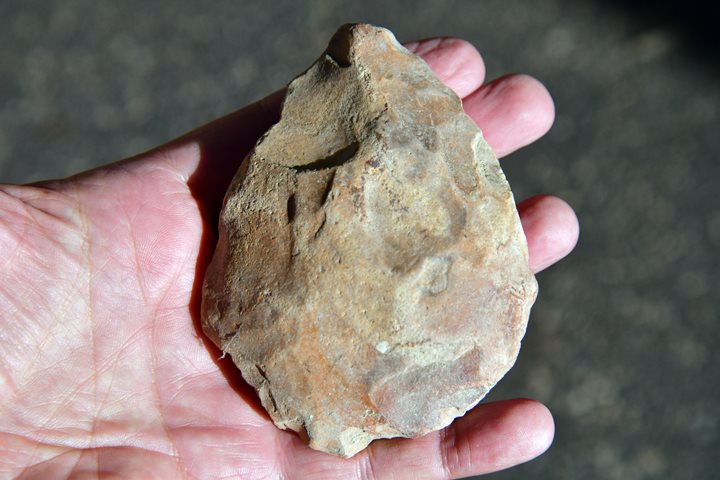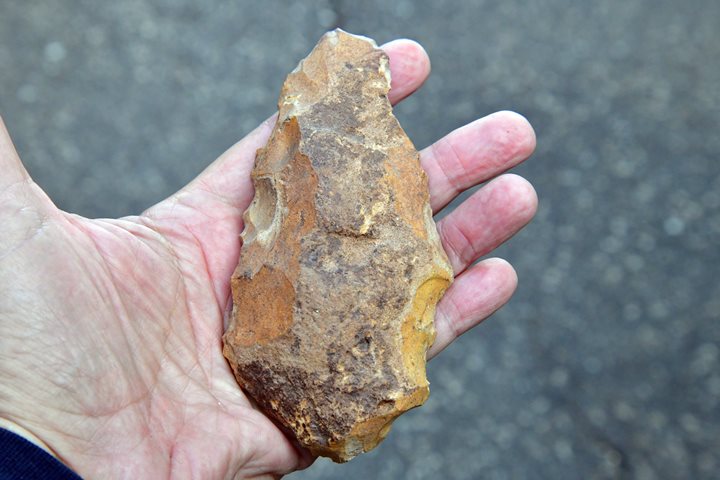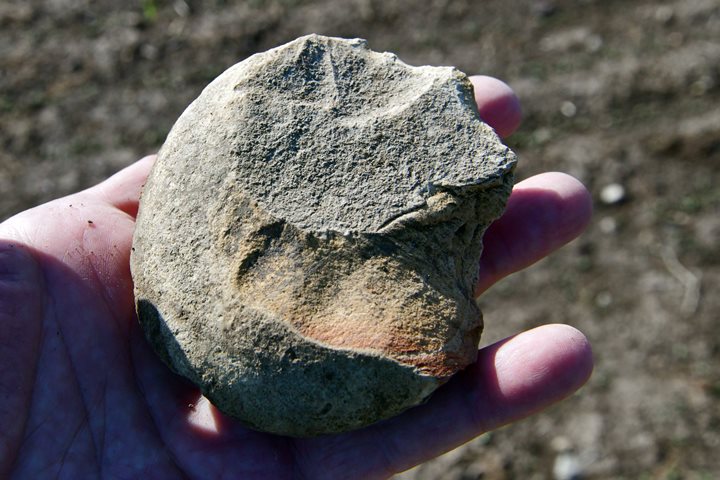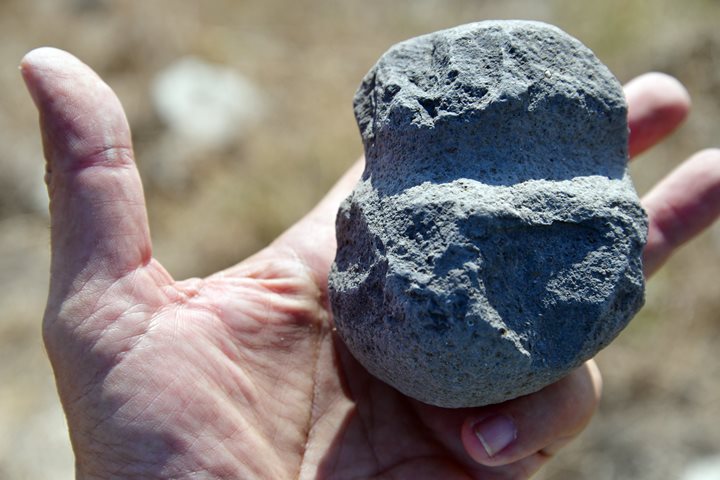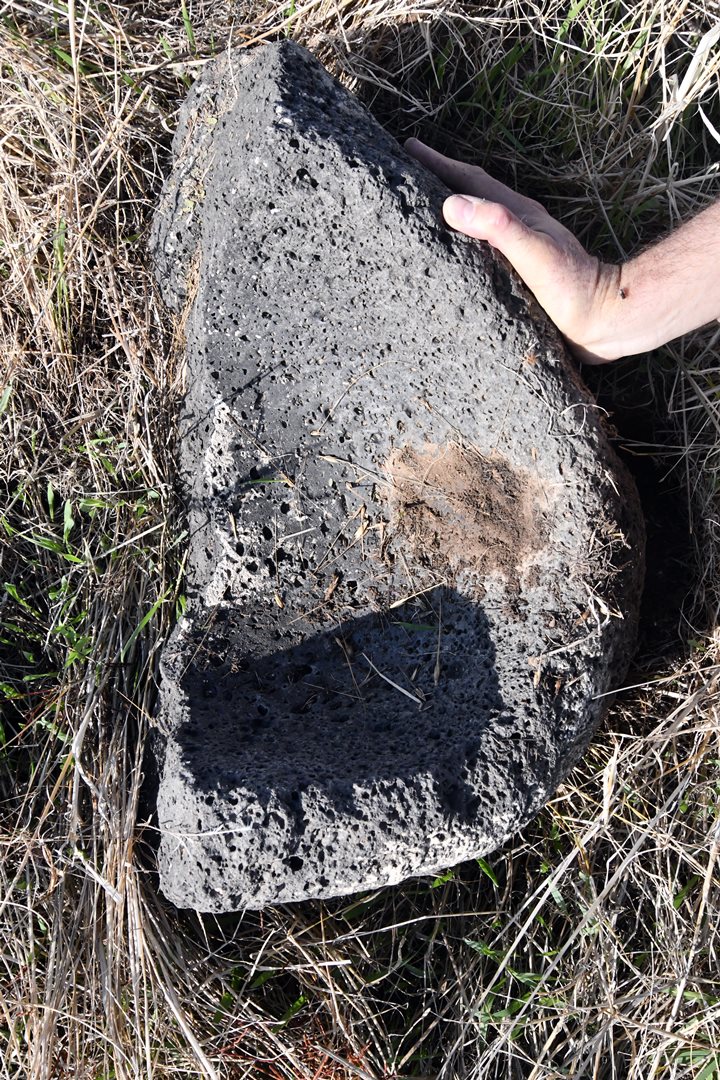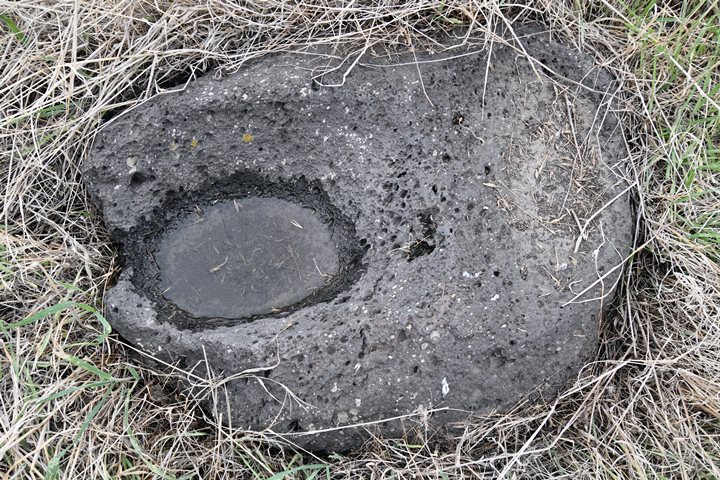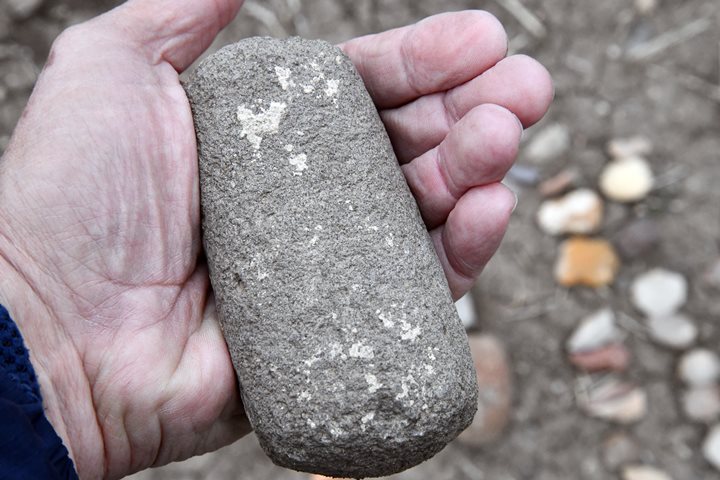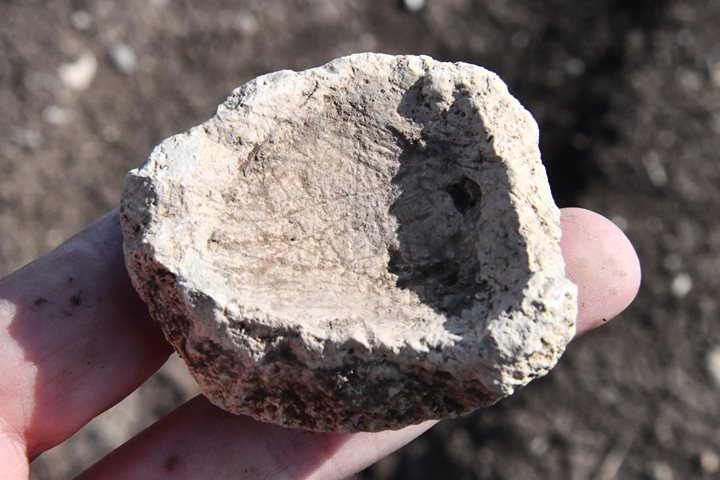Tools of the stone age, as found in BibleWalks sites.
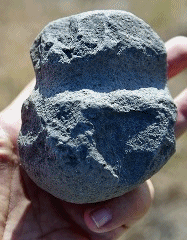
Home > Info > Prehistoric tools
Contents:
Overview
Tools
* Flint Hand Axes
* Choppers
* Basalt Hammer
* Flint blades
* Grinding Bases
* Bowls
Links
Etymology
Stone age periods:
The stone age periods are divided to the following divisions:
a. Paleolithic Age (Old Stone) periods:
- Lower (Early) Paleolithic 150,000 – 80,000 BC
- Three cultural phases: Early Acheulean, Late Acheulean and the Acheulo-Yabrodian.
- Choppers, hand axes and cleavers were typical stone tools
- Middle Paleolithic 80,000 – 40,000 BC
- Three cultural phases: Early Mousterian, Middle Mousterian, and Late Mousterian
- Made knives, scrapers and points out of flint
- Human species: Homo sapiens and the Neanderthal
- Upper (late) Paleolithic 40,000 – 16,000 BC
- Two cultural phases: Early Ahmarian and the Aurignacian cultures
- Ahmarian phase tools: retouched blades and small blades, points, end–scrapers and burins (chisel points)
- Aurignacian phase tools: retouched blades and small blades, flakes, thick blades, twisted small blades, carinated scrapers
- Material: flint tools, bone and horn objects, beads and the early stone grinding tools.
b. New stone age periods:
- Epi-Paleolithic 16,000 – 8,300 BC –
- domesticated plants and animals, and manufactured stone and bone tools.
- The last stage of cave dwelling
- Did not have pottery.
- Neolithic Period 8,300 -4,500 BC
- Started to make pottery
- Farmed and raised animals.
- Chalcolithic period 4,500 – 3,150 BC
- The tools were made of stone, ceramics and copper.
- Established many fortified cities.
Prehistoric Tools:
This section presents some of the prehistoric tools that were found in sites that were reviewed in BibleWalks:
(a) Hand axes
(1) Tel Zan foothills
This flint stone was found on the foothills of Tel Zan, on the north side of Tabor stream delta, 1km west of the Jordan river. It was probably brought in from a nearby location, as it was laying on the surface of the parking area.
This carved flint stone is identified as a hand axe of the lower-Paleolithic period. These tools, normally almond shaped (meaning: having an oval shape pointed at one or both ends) were a common tool that the early men made at this early period (150,000 – 80,000 BC).
(2) Nahal Arbel stream:
Another similar flint stone tool was found in Nahal Arbel, west of Kh. Asaad. It is also identified as a hand axe of the lower-Paleolithic period.
Example from the IAA collection of findings: Almond Shaped Hand Axe.
b) Choppers
Another typical Lower Paleolithic tool type was the chopper. Choppers are among the earliest and simplest tools created by early hominins, representing an essential aspect of the Oldowan stone tool industry style.
(1) Tel Zan foothills
This limestone pebble was found in the field between Tel Zan and the Tabor stream, 0.5km west of the Jordan river. Its core stone was 9cm in diameter and 3cm thick. Then, it was flaked on one side, thus creating a cutting edge.
Choppers are among the earliest and simplest tools created by early hominins, representing an essential aspect of the Oldowan stone tool industry style.
Key features of Paleolithic choppers include:
- Simple Design: Choppers have a relatively simple design compared to more advanced stone tools. They typically consist of a core stone that has been deliberately flaked to create a cutting edge. The opposite end of the tool often remains unmodified.
- Bifacial Flaking: Choppers are typically bifacial, meaning they are flaked on both sides. This bifacial flaking creates a sharp edge along one or more edges of the tool.
- Unifacial Choppers: Some choppers, however, are unifacial, meaning they are flaked on only one side. Unifacial choppers have a single sharp edge and an unmodified or minimally modified opposite side.
- Large and Heavy: Choppers are generally larger and heavier than the later Acheulean hand axes. They can vary in size, with some being small and handheld, while others are larger and potentially used for heavier cutting tasks.
- Function: Choppers were likely used for a variety of tasks, including butchering animals, processing plant materials, and possibly even woodworking. Their design and functionality make them suitable for tasks that involve chopping, slicing, and cutting.
- Cores and Flakes: Choppers are often associated with the concept of cores and flakes. The core is the original piece of stone from which flakes are struck to create tools. In the case of choppers, the core is often modified to create a functional cutting edge.
Choppers are a hallmark of the Oldowan tool tradition, which is one of the earliest known stone tool industries associated with early hominins like Homo habilis. These tools played a crucial role in the daily activities and survival strategies of early human populations, marking an important stage in the technological evolution of tool use. The use of choppers represents an early adaptation by hominins to modify their environment and utilize tools for various purposes.
Example from the IAA collection of findings: Chopping tool of Tel Ovadya.
(2) Horvat Minha
A similar chopper stone was found 700m west at Horvat Minha. Its core stone is 7cm in diameter and 2.5cm thick.
c) Hammers
This basalt stone was found in the lower settlement of Ein Shakhal, in the Nahal Tabor valley. The site near the find is an early bronze period settlement, so this may have also been of this period or the earlier Chalcolithic period.
The stone was used as a hammer, with a wooden handle that was holding it. You can notice that on both sides the stone was repeatedly hit with force, causing the surface of the stone to be smoother.
Around the stone is a groove that was used to tie the rope in order to fasten it to the handle. The process of cutting a groove or creating a notch in a stone tool to attach it to a handle is known as hafting. Hafting allowed early humans to combine different materials, such as attaching a stone tool like a basalt hammer to a wooden handle, creating a more versatile and effective tool. This technique is found in various prehistoric tools, including axes, adzes, and hammers.
In the case of a basalt hammer, a groove was cut around the stone to create a space for securing it to a wooden handle. The groove would typically match the shape of the handle and provide a secure fit. Once the stone tool was hafted to the wooden handle, it could be used with greater control and efficiency.
Hafting had several advantages:
- Increased Control: Attaching a stone tool to a handle increased the control that a person had over the tool. This was particularly important for tasks that required precision or force.
- Versatility: Hafting allowed for the use of different materials for different parts of the tool. For example, a hard stone could be used for the cutting or striking edge, while a flexible wooden handle provided a comfortable grip.
- Reuse of Handles: If the stone tool became dull or damaged, it could be re-sharpened or replaced without discarding the entire tool. This made tools more economical and sustainable.
- Tool Modification: Hafting also allowed for the modification and adaptation of tools. A particular stone head could be used for various purposes by changing the hafting arrangement.
Hafting technology represents a significant advancement in the toolkit of early humans, contributing to their ability to adapt to different environments, hunt, and process materials more efficiently. The archaeological record provides evidence of hafted tools dating back tens of thousands of years, showcasing the ingenuity and resourcefulness of our ancestors.
In the photo below – the ancient hammer was reconstructed by mounting the stone between a forked branch, then wrapping it with ropes, using the hafting technique.
A 3D model of the ancient hammer was scanned using the Scaniverse app. Pressing on the following photo will open a mp4 video player with a 3d model of this tool, revolving around its axis.
Prehistoric hammers made of basalt stone were tools created by ancient human populations for various tasks, such as shaping other stone tools, woodworking, or pounding and crushing different materials. Basalt is a type of volcanic rock that was readily available in certain regions, and its hardness and durability made it a suitable material for tool manufacturing. Here are some key aspects of prehistoric basalt stone hammers:
- Material: Basalt is an igneous rock that is rich in minerals like feldspar and pyroxene. Its fine-grained texture and hardness made it suitable for tool production, as it could withstand the impact and abrasion associated with hammering activities.
- Manufacturing: Prehistoric people would select suitable basalt cobbles or nodules and then shape them into hammerstones by striking them with other rocks to create the desired form. The process might involve pecking, grinding, and polishing to refine the shape and improve the ergonomics.
- Use as Hammerstones: Basalt hammers were used as hammerstones in various tasks. They served as percussive tools for shaping other stone tools by flaking, knapping, or grinding. The hard and durable nature of basalt made these hammers effective for striking and breaking rocks to produce sharp-edged tools.
- Workshop Tools: Basalt hammers were likely essential components of prehistoric workshops where stone tools were manufactured. These tools would have been used alongside other implements like antler or bone tools for more delicate shaping.
- Durability and Reusability: Basalt hammers, due to their hardness, had a degree of durability that allowed for repeated use. While they might show signs of wear over time, they could be resharpened or reshaped as needed.
- Cultural Significance: The use of basalt hammers varied across different prehistoric cultures and time periods. The presence of basalt tools in archaeological sites can provide insights into the available resources, trade networks, and technological capabilities of ancient societies.
d) Blades
Flint was used to manufacture tools during the stone age, such as knives and arrow heads. It is hard and splits into thin, sharp splinters. In the prehistoric sites there are many such tools found on the surface. Flint blades were crucial components of the toolkits used by Neolithic communities for various purposes.
Examples of flint blades were found in the Neolithic site of Horvat Minha (Munhata) – ruins of a large Neolithic (New stone Age) period settlement. The site is located on a high terrace, situated above the north bank of Nahal Tabor stream. This site had 3 settlement periods: Pre Pottery Neolithic B – 8000 BC to 7210 BC, Late Neolithic Pottery period (6400-4500 BC), and Chalcolithic period (4500-3150 BC) up to Early Bronze 1A.
This flint stone was used as a sickle blade, or knife, or arrow head:
Here are key features and aspects of Neolithic flint blades:
- Material: Flint, a type of microcrystalline quartz, was a popular raw material for toolmaking during the Neolithic period. Its conchoidal fracturing properties made it suitable for producing sharp edges when struck or pressure-flaked.
- Blade Characteristics: Flint blades are characterized by their elongated, narrow shape with parallel edges. These blades were typically produced through a process called pressure flaking, where controlled force is applied to the edges of a prepared flint core, causing flakes to detach and create a sharp blade.
- Use as Cutting Tools: Neolithic flint blades were versatile cutting tools used for a variety of tasks, including butchering animals, processing plants, and cutting materials for construction. The sharp edges of the blades made them effective for slicing and cutting.
- Hafting: Some Neolithic flint blades were hafted, meaning they were attached to handles or shafts to create tools with improved handling and cutting capabilities. Hafted blades might have been used for woodworking or other specialized tasks.
- Trade and Exchange: Flint, not always readily available in all regions, was sometimes traded over considerable distances. The presence of flint blades made from materials not locally available can indicate trade networks and cultural interactions.
- Regional Variations: Neolithic flint blades can exhibit regional variations in terms of design and technology. Different Neolithic cultures may have developed specific techniques for blade production, resulting in distinctive styles.
- Archaeological Significance: The discovery of Neolithic flint blades at archaeological sites provides valuable insights into the technology, economy, and daily activities of Neolithic communities. Analysis of blade types and production techniques can contribute to our understanding of social organization and cultural exchange during this period.
Overall, Neolithic flint blades played a crucial role in the practical aspects of Neolithic life, contributing to the success of early agricultural communities as they adapted to changing lifestyles and technologies.
Other samples of flint blades found on Horvat Minha are seen below:
e) Grinding bases
The Neolithic period witnessed significant advancements in human culture, including the development of agriculture, domestication of animals, and the transition from nomadic to settled lifestyles.
A basalt grinding base typically consists of a flat or slightly concave surface made of basalt, a volcanic rock known for its hardness and durability. The grinding base was used in conjunction with a hand-held grinding tool, such as a smaller stone or pestle, to grind, crush, or pulverize various materials, including grains, seeds, and other food items. This grinding activity was a crucial part of early agricultural societies, as it allowed for the processing of plant materials into food products.
A section of a large basalt grinding base was unearthed in the excavations of Horvat Minha (Munhata) – a large Neolithic (New stone Age) period settlement situated above the north bank of Nahal Tabor stream.
The grinding base would have a flat or slightly concave surface to provide a stable area for grinding activities. Wear patterns on the surface of the grinding base can be used to understand its use over time, and may indicate the types of materials that were ground or the frequency of use.
Another large grinding base from this settlement:
A hand-held grinding tool, a small round basalt stone, was also found in this settlement.
A small limestone grinding base was also found in this settlement. It measures 7-12 cm by 10-11 cm, and 3-3.5 cm wide.
A similar example from the IAA collection of findings: Limestone cupmark, of the Pottery Neolithic A period, found in Sha`ar ha-Golan (10km NE).
f) Bowls
A base of a small limestone bowl was found in Horvat Minha (Munhata) – a large Neolithic (New stone Age) period settlement situated above the north bank of Nahal Tabor stream.
Notice the wear scratches on the surface of the concave base.
Links:
* External links
- Human Evolution – Encyclopædia Britannica
- Seven Million years of human evolution (Youtube; American Museum of Natural history)
- Human Origins 1010 (Youtube, National Geographic, 3:47minutes)
- IAA collection of findings
* Internal links:
- Prehistoric sites – sites reviewed in BibleWalks
- Dolmens (Bronze age)
Etymology – behind the name:
- Lithic – Stone
- Paleolithic period means:”old stone”, from the Greek words: Paleos-old, Lithos-stone.
- Epi-Paleolithic period means: “After old stone”; Epi – After. Epi-Paleolithic- after the “old stone”.
- Neolithic period is based on the words: “new” stone age (neo=new, Lithos- stone).
- Chalcolithic period is based on the word: Chalcos – copper in Greek.
![]()
BibleWalks.com – exploring the history of the land and what came before it
Prehistoric sites<<<—previous —<<<Info>>>— next Info—>>> Extreme sports
This page was last updated on June 22, 2024 (add chopper)
Sponsored Links:
